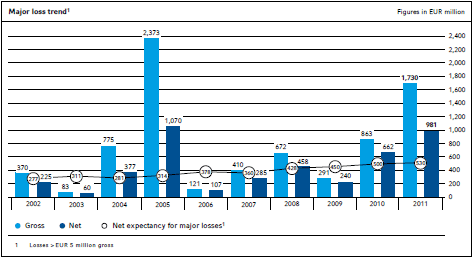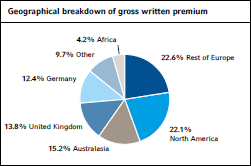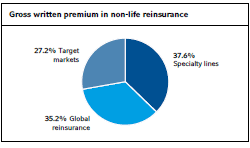Non-life reinsurance
| Key figures for non-life reinsurance | Figures in EUR million | |||||
|---|---|---|---|---|---|---|
| 2011 | +/- previous year |
2010 | 2009 | 2008 | 2007 | |
1 Including expenses on funds withheld and contract deposits |
||||||
| Gross written premium | 6,825.5 | +7.7% | 6,339.3 | 5,746.6 | 4,987.8 | 5,189.5 |
| Net premium earned | 5,960.8 | +10.5% | 5,393.9 | 5,229.5 | 4,276.7 | 4,497.6 |
| Underwriting result | (268.7) | 82.4 | 143.5 | 184.7 | (26.7) | |
| Net investment income | 845.4 | +17.2% | 721.2 | 563.2 | 11.1 | 783.3 |
| Operating result (EBIT) | 599.3 | -31.9% | 879.6 | 731.4 | 2.3 | 656.7 |
| Group net income | 455.6 | -21.6% | 581.0 | 472.6 | (160.9) | 549.5 |
| Earnings per share in EUR | 3.78 | -21.6% | 4.82 | 3.92 | (1.33) | 4.56 |
| Retention | 91.3% | 88.9% | 94.1% | 88.9% | 82.5% | |
| Combined ratio1 | 104.3% | 98.2% | 96.6% | 95.4% | 99.7% | |
Accounting for 56.4% of our premium volume, non-life reinsurance is Hannover Re’s largest business group. We do not pursue any growth targets here, but instead practise active cycle management according to which we expand our business if the rate situation is favourable and scale back our portfolio if prices are inadequate.
The situation on the international reinsurance markets was broadly favourable in the year under review. The renewals in non-life reinsurance as at 1 January 2011 – the date when around 67% of our treaties in traditional reinsurance were renegotiated – passed off better than initially expected by some market players. Even though market conditions were tending to soften, we had sufficient opportunities to write profitable business. Prices and conditions essentially remained stable. All in all, we boosted our premium volume by around 2% in the 1 January treaty renewals.
Rate increases were recorded in the treaty renewals during the year, especially in reinsurance lines exposed to natural catastrophes. The price rises were driven by the enormous major losses incurred in the first quarter of 2011. Yet even under loss-free reinsurance programmes from regions that were spared major claims, rate increases were in some cases obtained.
In the aftermath of the devastating earthquake in Japan in March of the year under review, as anticipated, price increaseswere pushed through for non-proportional earthquake covers as well as improved conditions under proportional treaties. Prices also rose in personal accident reinsurance and for industrial fire programmes. During the renewals our company set great store by supporting our Japanese clients in these difficult times and providing them with the necessary capacity. The treaty negotiations for Australia and New Zealand as at 1 April and 1 July 2011 similarly brought about substantial price adjustments, both for loss-impacted programmes and those that had been spared losses. This was especially true of New Zealand, which suffered extensive damage from earthquakes in both 2010 and 2011. We were also satisfied with the treaty renewals in other Asian markets; here, too, we slightly enlarged our premium volume.
In North America – our largest single market – we were similarly able to secure rate improvements over the course of the year. This was the result both of strains incurred by the US insurance industry from tornado and flood events as well as model adjustments made by the agency Risk Management Solutions (RMS).
The treaty renewals once again demonstrated that ceding companies continue to attach great importance to a reinsurer’s financial strength. A very good rating is indispensable for a reinsurer seeking to be offered and awarded the entire spectrum of business. With its outstanding ratings (“AA–” from Standard & Poor’s and “A” from A.M. Best) Hannover Re is one of the reinsurers that meet this requirement without reservation.
All in all, the available market opportunities in non-life reinsurance were highly satisfactory, enabling us to grow profitably in the year under review and expand our market share. The focus of our activities was on the markets of China, Central and Eastern Europe as well as facultative reinsurance and agricultural risks.
Details of developments in the individual markets are provided on the following pages.
We anticipate growth stimuli from the more exacting requirements placed on the risk capital resources of insurance undertakings as a consequence of the introduction of Solvency II; for such companies, the transfer of risk to reinsurers with good ratings constitutes an economically attractive alternative.
The gross premium volume for our non-life reinsurance business group increased by 7.7% in the year under review to EUR 6.8 billion (EUR 6.3 billion). At constant exchange rates, especially against the US dollar, growth would have come in at 9.4%. The level of retained premium climbed from 88.9% to 91.3%. Net premium earned grew by 10.5% to EUR 6.0 billion (EUR 5.4 billion); growth would have been 12.1% at constant exchange rates. The increase was thus stronger than anticipated; at the beginning of the year the forecast for 2011 had been in the range of 0% to 3% at unchanged exchange rates.
Even though the hurricane season in North and Central America again passed off thoroughly moderately, the (re)insurance industry was nevertheless faced with extraordinarily heavy burdens in the year under review. The largest loss event for the insurance industry was the earthquake in Japan and the resulting tsunami. This event produced a net strain for our company of EUR 228.7 million. Yet the flooding in Thailand and the earthquake in New Zealand also resulted in a heavy major loss incidence. The associated expenditures incurred by Hannover Re amounted to EUR 195.7 million and EUR 121.4 million respectively. These and other major losses produced a net burden of catastrophe losses and major claims totalling EUR 980.7 million for the year under review (EUR 661.9 million). Not only did this figure surpass the already unusually high volume of the previous year, it also far exceeded the expected level of around EUR 530 million. The combined ratio consequently rose from 98.2% to 104.3%.
The underwriting result deteriorated to –EUR 268.7 million (EUR 82.4 million). Net investment income climbed by a very pleasing 17.2% to EUR 845.4 million (EUR 721.2 million). The operating profit (EBIT) for non-life reinsurance contracted to EUR 599.3 million (EUR 879.6 million) as at 31 December 2011 on account of the heavy major loss expenditure. Group net income closed at EUR 455.6 million, following EUR 581.0 million in the comparable period. The business result was favourably influenced by a tax refund of EUR 128.0 million deriving from a decision of the Federal Fiscal Court (BFH). Earnings per share stood at EUR 3.78 (EUR 4.82).
In the following pages we report in detail on our non-life reinsurance business group, which is split into three segments according to the areas of responsibility on the Executive Board: target markets, specialty lines and global reinsurance.



